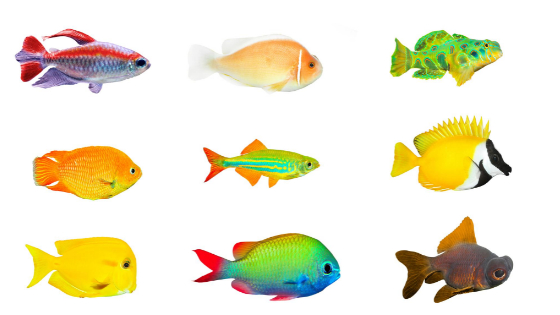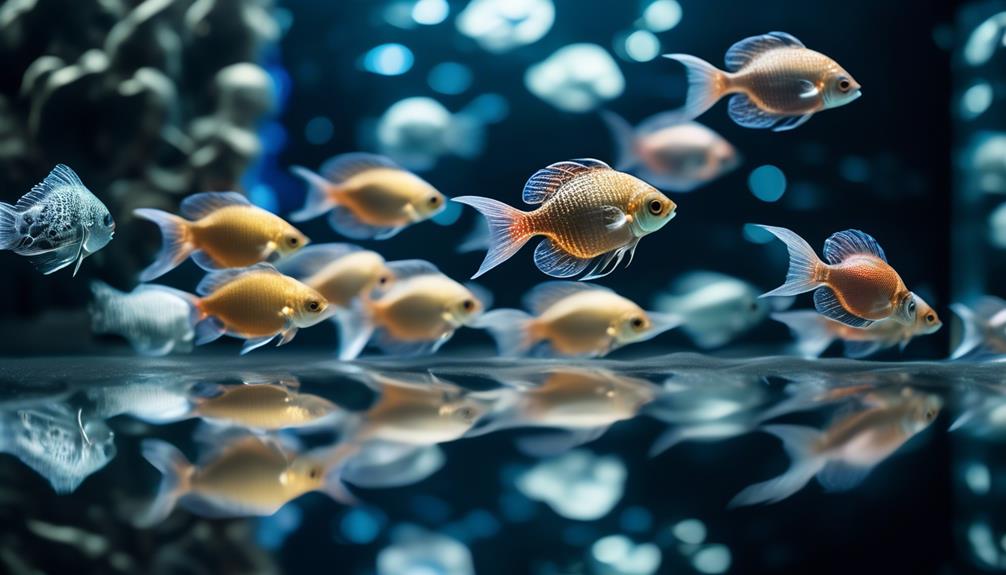
Have you ever wondered if there is a fish out there that can truly enhance the beauty of your aquarium? Well, look no further because exotic Silver Dollars might just be the perfect addition you've been searching for.
With their shimmering silver scales and graceful demeanor, these freshwater treasures are known to add a touch of elegance to any large aquarium.
But there's more to them than meets the eye. So, what makes these Silver Dollars so special? Let's dive in and explore their unique features and captivating behavior that will leave you wanting to know more.
Key Takeaways
- Silver Dollars are medium-sized, freshwater fish species with a non-aggressive temperament, making them suitable for large aquariums.
- They originate from the Amazon River in South America and have silver-colored scale-less bodies.
- Silver Dollars require large aquariums and should be kept in shoals of 6 fish or more.
- They are voracious plant eaters, making it difficult to keep live plants in their tank.
General Description and Origins
Silver Dollars are a popular freshwater fish species known for their medium size, non-aggressive temperament, and stunning silver-colored scale-less bodies. These fish can grow up to 10 inches in length and are active swimmers, so they require large aquariums of at least 50 gallons.
It's best to keep them in shoals of six fish or more to ensure their well-being. Silver Dollars originate from the Amazon River in South America and are commonly found in the middle swimming region of the tank. They're peaceful in nature but may eat smaller fish, so it's important to choose tank mates wisely.
Maintenance and Care
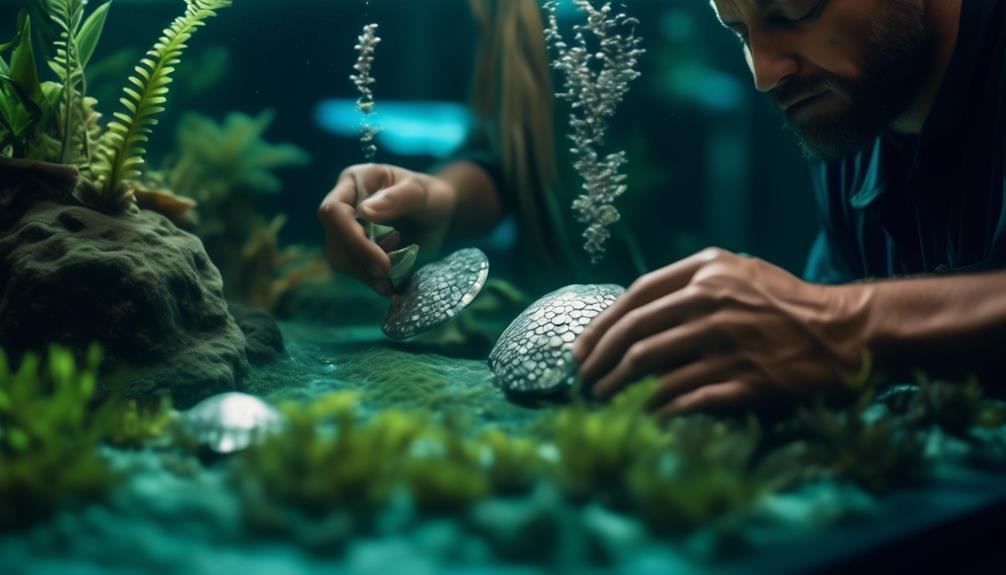
To properly care for Silver Dollars in your aquarium, it's important to understand the maintenance and care requirements of these beautiful fish. Here are the key aspects to consider:
- Tank size: Silver Dollars can grow up to 10 inches in length, so they need a large aquarium of at least 50 gallons to swim freely.
- Tank setup: Create a dimly lit environment with driftwood and caves to mimic their natural habitat. However, be aware that Silver Dollars are voracious plant eaters, making it difficult to keep live plants.
- Tank mates: While Silver Dollars are generally peaceful, they may eat smaller fish. They can be kept with compatible species such as Phantom Tetras, Buenos Ares Tetras, Oscars, Convict Cichlids, Jack Dempseys, and Angel Fish. Make sure to have a tight-fitting lid to prevent them from jumping out.
- Feeding and breeding: Silver Dollars are mainly vegetarians and can be fed algae wafers, spinach, peas, and supplemented with live or frozen foods. Breeding pairs can be established by raising juveniles together in a heavily planted spawning tank with reduced water hardness and increased temperature.
Tank Mates and Behavior
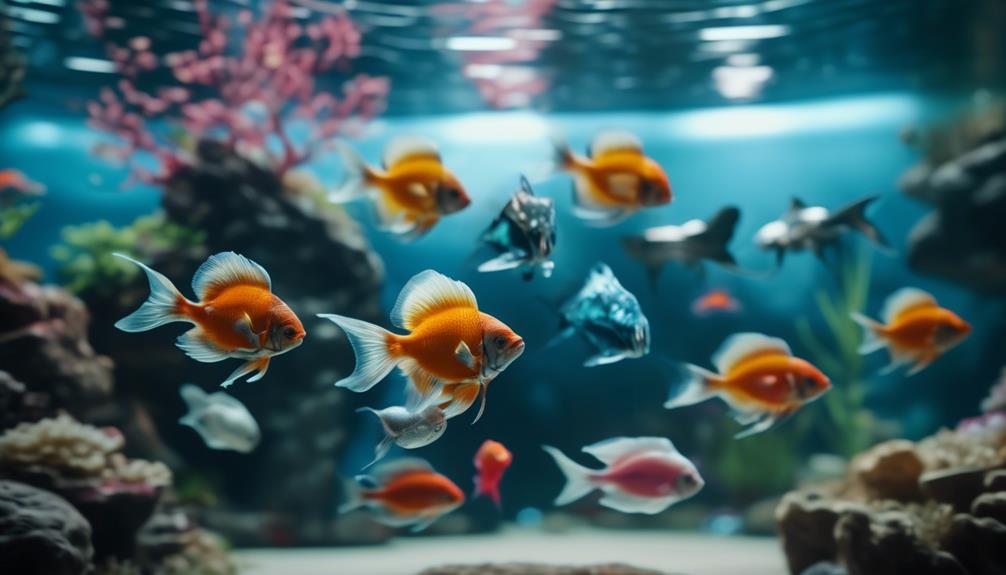
When considering tank mates for your Silver Dollars, it's important to choose species that can coexist peacefully and minimize the risk of smaller fish being eaten. Silver Dollars are generally peaceful in nature but may eat smaller fish. They can be kept in most community aquariums and are compatible with Phantom Tetras, Buenos Ares Tetras, Oscars, Convict Cichlids, Jack Dempseys, and Angel Fish.
However, it's important to note that Silver Dollars may jump out of the aquarium, so a tight-fitting lid is necessary. Additionally, they require well-filtered aquariums and sporadic water changes to maintain their health.
Feeding and Breeding
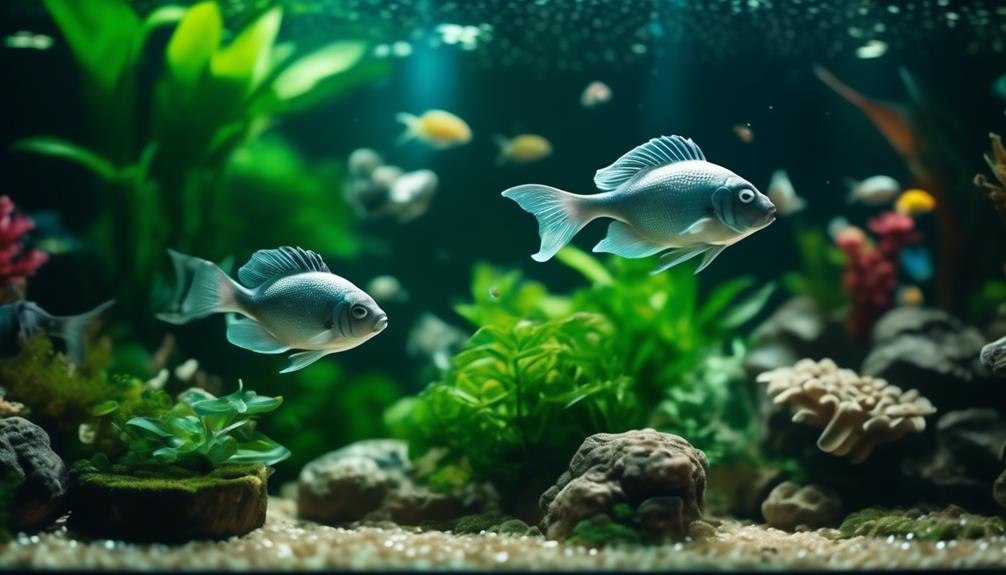
If you want to ensure the health and successful breeding of your Silver Dollars, it's essential to understand their feeding habits and breeding requirements. Here are the key points you need to know:
- Feeding: Silver Dollars are mainly vegetarians, so provide them with a diet rich in plant-based foods like algae wafers, spinach, and peas. You can also supplement their diet with live or frozen foods.
- Breeding: To establish breeding pairs, raise juveniles together. Set up a spawning tank with reduced water hardness and increased temperature. A heavily planted tank is essential for successful breeding.
- Water changes: Silver Dollars require well-filtered aquariums and sporadic water changes to maintain water quality and promote breeding behavior.
- Tank setup: Dimly lit aquariums with driftwood and caves provide a suitable environment for Silver Dollars to thrive and breed.
Suitable Tank Size
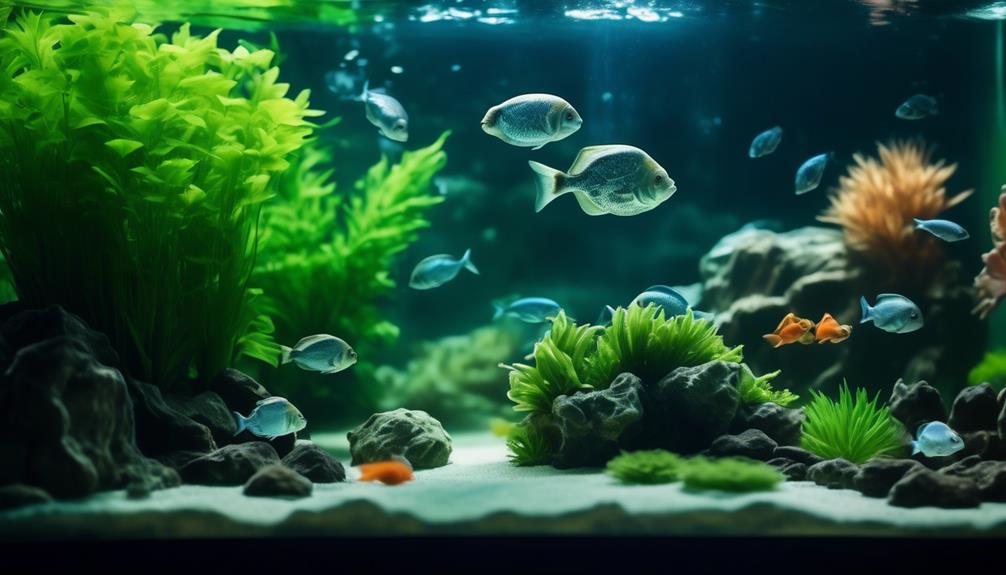
A spacious aquarium is essential for housing Silver Dollars and providing them with the optimal environment for their growth and well-being. These freshwater fish species are medium-sized and can grow up to 10 inches in length. They are active swimmers and need large tanks to accommodate their movement. To give you an idea of the suitable tank size, here is a table showcasing the recommended tank sizes for different fish species:
| Fish Species | Minimum Tank Size |
|---|---|
| Silver Dollars | 50+ gallons |
| Phantom Tetras | 20+ gallons |
| Buenos Ares Tetras | 30+ gallons |
| Oscars | 75+ gallons |
| Convict Cichlids | 30+ gallons |
As you can see, Silver Dollars require a tank size of at least 50 gallons to thrive. It is important to provide them with enough space to swim and explore, as overcrowding can lead to stress and health issues. So, when setting up your aquarium for Silver Dollars, make sure to choose a tank that meets their size requirements.
Ideal Tank Setup
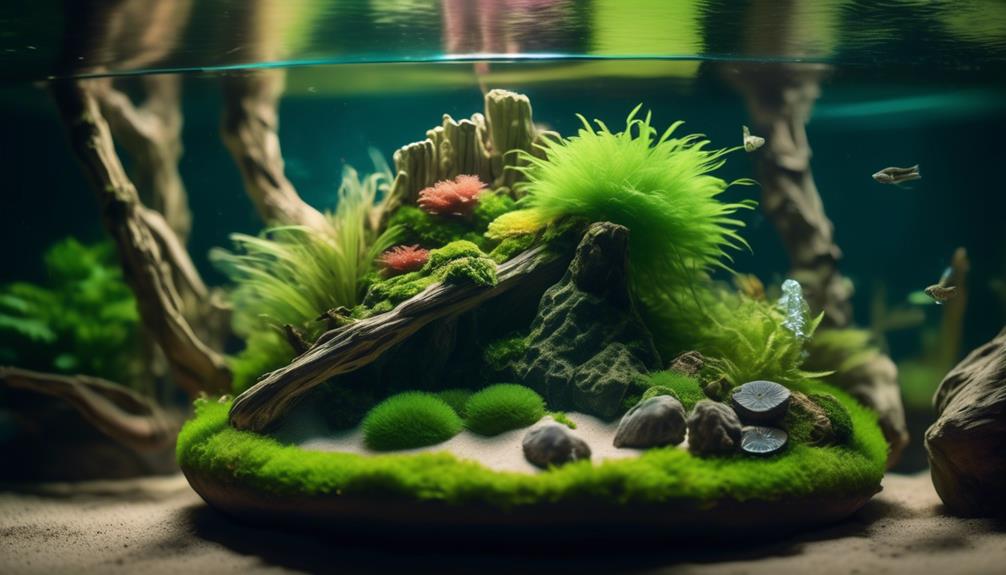
What are the key components of an ideal tank setup for Silver Dollars?
To create the perfect environment for your Silver Dollars, consider the following:
- Tank Size: Provide a spacious aquarium of at least 50 gallons to accommodate their active swimming behavior and shoaling nature.
- Lighting and Decor: Opt for a dimly lit setup with driftwood and caves to mimic their natural habitat. However, keep in mind that Silver Dollars are voracious plant eaters, so live plants may be challenging to maintain.
- Tank Mates: Silver Dollars are generally peaceful, but they may eat smaller fish. They can be kept with community fish such as Phantom Tetras, Buenos Ares Tetras, Oscars, Convict Cichlids, Jack Dempseys, and Angel Fish. Ensure a tight-fitting lid, as Silver Dollars have been known to jump out of the aquarium.
- Filtration and Water Changes: Maintain a well-filtered aquarium and perform sporadic water changes to keep the water quality optimal for their health and well-being.
Compatible Fish Species
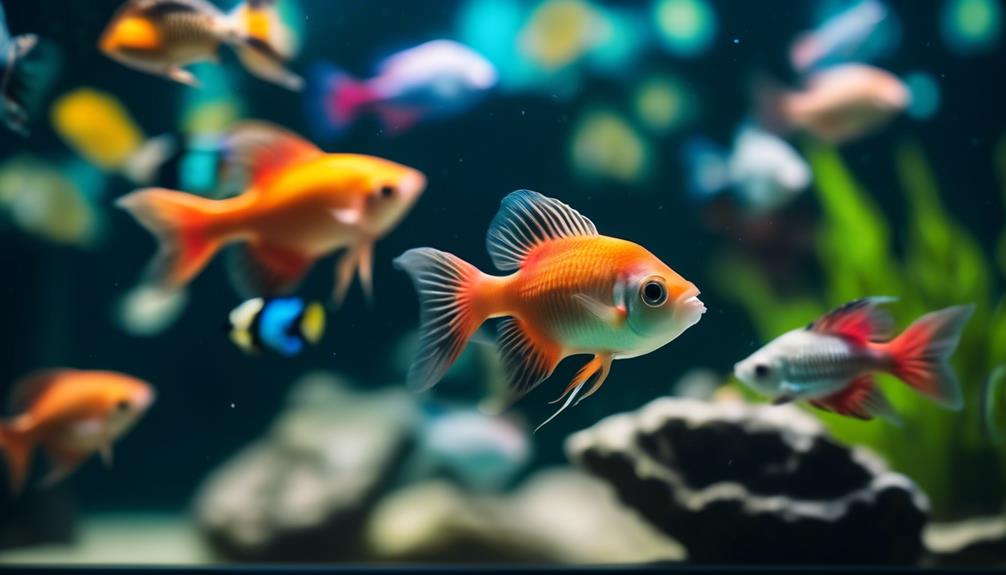
When selecting compatible fish species for your Silver Dollars, it's important to consider their peaceful nature and potential size differences. Silver Dollars are known for their peaceful temperament, but they may eat smaller fish. It's best to keep them in a community aquarium with fish of similar size and temperament.
Compatible tank mates for Silver Dollars include Phantom Tetras, Buenos Ares Tetras, Oscars, Convict Cichlids, Jack Dempseys, and Angel Fish.
It's also important to note that Silver Dollars may jump out of the aquarium, so a tight-fitting lid is necessary. Additionally, they require well-filtered aquariums and sporadic water changes to maintain their health and well-being.
Preventing Plant Damage
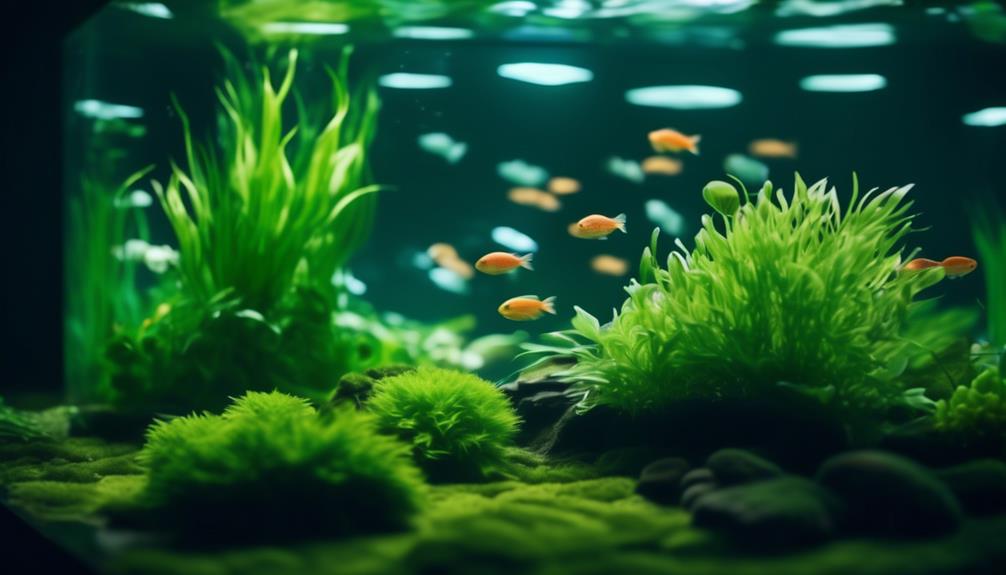
To prevent plant damage in your aquarium, it's important to consider the herbivorous nature of Silver Dollars and take necessary precautions. Here are four ways you can protect your plants:
- Choose hardy plants: Opt for robust and fast-growing plant species that can withstand the grazing habits of Silver Dollars. Plants like Java Fern, Anubias, and Amazon Swords are good options.
- Provide alternative food sources: Supplement the Silver Dollars' diet with vegetables like spinach, lettuce, and zucchini. This will help divert their attention from your live plants.
- Use plant anchors: Secure your plants firmly in the substrate using plant anchors or weights. This will make it harder for the Silver Dollars to uproot or damage them.
- Create hiding spots: Incorporate driftwood, rocks, and caves into your aquarium design. These hiding spots will give your plants some protection and reduce the likelihood of them being targeted by the Silver Dollars.
Benefits of Live Plants
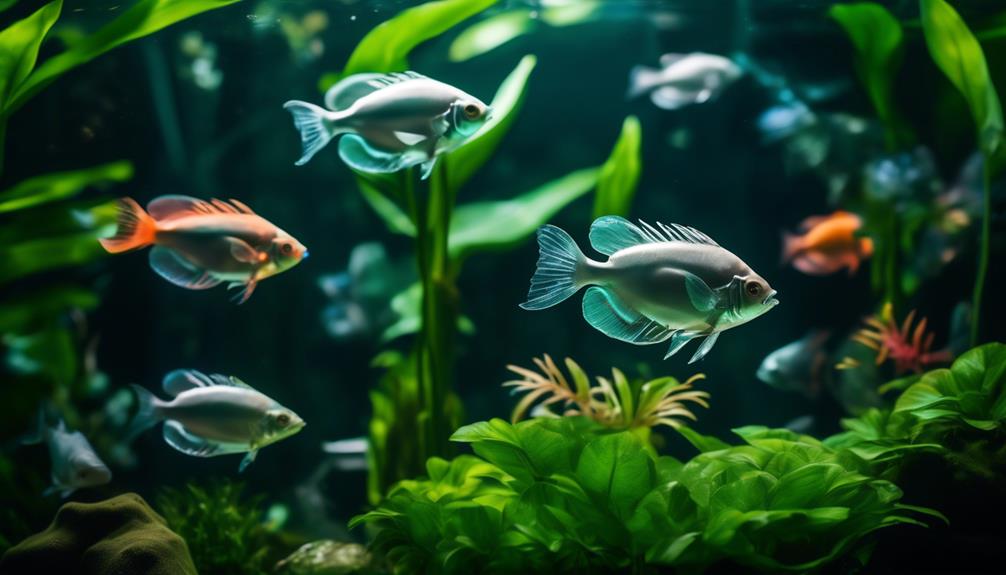
Live plants in aquariums offer a range of benefits for both the fish and the overall ecosystem.
For the fish, live plants provide a natural and comfortable environment that mimics their natural habitat. The plants offer shelter and hiding places, reducing stress and promoting the overall well-being of the fish.
Additionally, live plants help to oxygenate the water, ensuring that there's an adequate supply of oxygen for the fish to breathe. They also help to stabilize the pH levels in the aquarium, creating a more stable and healthy environment for the fish.
Furthermore, live plants utilize the nutrients in the water, reducing the risk of algae growth and promoting a clean and clear aquarium.
Achieving Balance in a Planted Tank
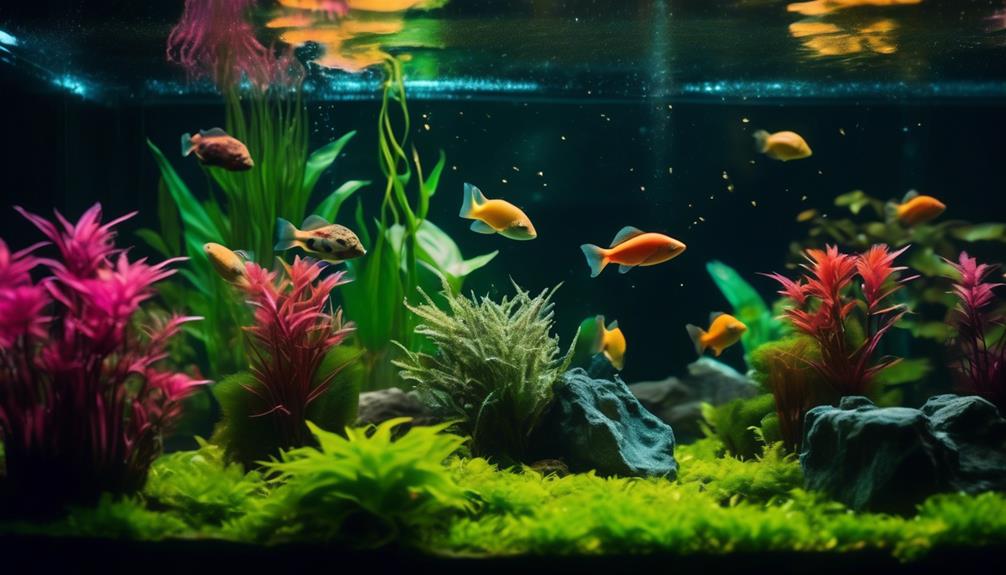
Adding live plants to your aquarium not only enhances the aesthetic appeal and provides numerous benefits for the fish and the ecosystem, but it also requires careful attention to achieve a delicate balance in a planted tank. Here are four important factors to consider when striving for balance in your planted tank:
- Lighting: Ensure that your tank receives the right amount of light. Too much light can lead to excessive algae growth, while too little light can hinder plant growth.
- Substrate: Choose a substrate that provides adequate nutrients for plant growth. Consider using a nutrient-rich substrate or supplementing with root tabs or liquid fertilizers.
- CO2 Levels: Maintain proper carbon dioxide (CO2) levels in your tank. CO2 supplementation can promote healthy plant growth and prevent algae outbreaks.
- Water Parameters: Monitor and maintain appropriate water parameters, including temperature, pH, and hardness. Different plant species have specific requirements, so it's important to research and adjust accordingly.
Spawning Tank Requirements
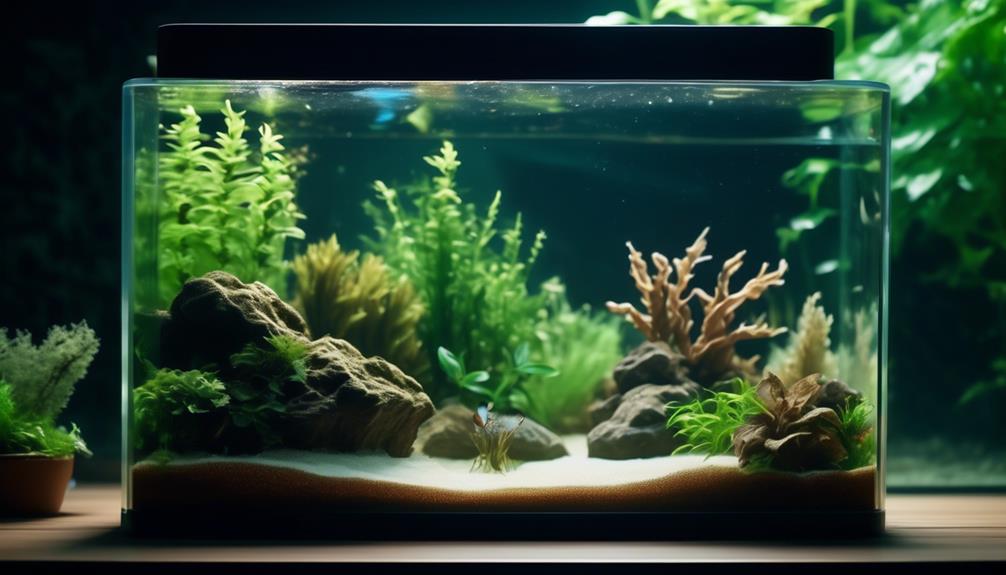
When preparing a spawning tank for Silver Dollars, it is important to create an environment that promotes successful breeding. To ensure the best conditions for breeding, here are the key requirements for a spawning tank:
| Spawning Tank Requirements | |
|---|---|
| Water Hardness | Reduced to 2-4 dGH |
| Temperature | Increased to 78-82°F |
| Lighting | Dim, with subdued lighting |
| Substrate | Fine gravel or sand |
| Plants | Heavily planted with floating plants |
| Filtration | Gentle flow with sponge or pre-filter |
| Spawning Medium | Fine-leaved plants or spawning mops |
| Water Quality | Regular water changes and monitoring |
Additional Tetra and Corydoras Options
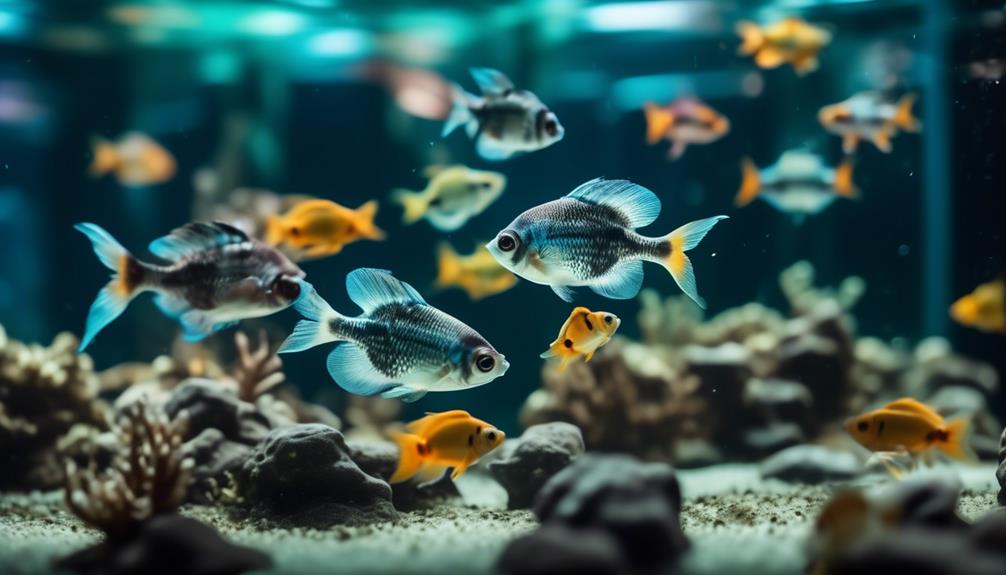
To expand your options for tetras and corydoras in your aquarium, consider a few more species that can thrive in a planted tank:
- Neon Tetra: Known for their vibrant colors, neon tetras are peaceful and make great tank mates for silver dollars. They prefer a heavily planted tank with dim lighting.
- Bandit Cory: These bottom-dwelling fish have a striking black mask over their eyes, giving them a unique appearance. They're excellent scavengers and can help keep the tank clean.
- Panda Cory: With their adorable black and white markings, panda cories are a popular choice for planted tanks. They're peaceful and enjoy being in groups.
- Skunk Cory: Skunk cories have a distinct black stripe running along their body, resembling a skunk. They're hardy and can adapt to different water conditions.
Adding these tetra and corydoras options to your aquarium won't only enhance the visual appeal but also contribute to a harmonious and thriving aquatic community.
Frequently Asked Questions
Can Silver Dollar Fish Be Kept in a Small Aquarium?
No, silver dollar fish cannot be kept in a small aquarium. They require a large tank, at least 50 gallons, due to their medium size and active swimming behavior.
Are Silver Dollar Fish Suitable for Beginners?
Yes, silver dollar fish are suitable for beginners. They are peaceful and can be kept in most community aquariums. Just make sure to provide a large tank, suitable tank mates, and a well-filtered environment.
How Often Should Water Changes Be Done for Silver Dollar Fish?
You should do water changes for your silver dollar fish regularly. This helps maintain water quality and keeps your fish healthy. Aim for weekly water changes, removing about 20-30% of the tank water each time.
Can Silver Dollar Fish Be Kept With Aggressive Fish Species?
Yes, silver dollar fish can be kept with aggressive fish species. They are peaceful in nature but may eat smaller fish. They are compatible with Phantom Tetras, Buenos Ares Tetras, Oscars, Convict Cichlids, Jack Dempseys, and Angel Fish.
What Is the Lifespan of Silver Dollar Fish?
The lifespan of silver dollar fish varies, but they can live up to 10 years with proper care. Providing a well-filtered tank, a balanced diet, and a suitable environment will help ensure their longevity.
Do Paradise Fish and Silver Dollars Get Along in the Same Aquarium?
Yes, exotic paradise fish for enthusiasts and silver dollars can coexist in the same aquarium, but caution is required. Both species are peaceful, but paradise fish can be territorial, especially during breeding. A spacious tank with plenty of hiding spots and visual barriers will help minimize conflict between the two types of fish.
Conclusion
In conclusion, the exotic Silver Dollar fish is a stunning and peaceful addition to any large aquarium. With their silver-colored bodies and active swimming behavior, they add elegance and beauty to the tank.
By providing a suitable habitat with plenty of driftwood and caves, along with compatible tank mates, you can ensure the well-being and socialization of your Silver Dollars.
With proper care and attention, your aquarium will thrive with these captivating freshwater beauties.




